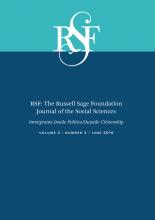Research ArticleII. The Social Dimensions of Political Engagement
Open Access
A Different Hue of the Gender Gap: Latino Immigrants and Political Conservatism in the United States
Katharine M. Donato, Samantha L. Perez
RSF: The Russell Sage Foundation Journal of the Social Sciences June 2016, 2 (3) 98-124; DOI: https://doi.org/10.7758/RSF.2016.2.3.06
Katharine M. Donato
aProfessor of sociology at Vanderbilt University
Samantha L. Perez
bDoctoral student in sociology at Vanderbilt University

REFERENCES
- ↵
- Arceneaux, Kevin
- ↵
- Bafumi, Joseph, and
- Robert Y. Shapiro
- ↵Bejarano, Christina E. 2013. The Latino Gender Gap in US Politics. New York: Routledge.
- ↵
- Bejarano, Christina E.,
- Sylvia Manzano, , and
- Celeste Montoya
- ↵Campbell, Angus, Philip E. Converse, Warren E. Miller, and Donald E. Stokes. 1960. The American Voter. New York: John Wiley & Sons.
- ↵Center for the American Woman and Politics (CAWP). 2012. “The Gender Gap: Voting Choices in Presidential Elections.” Fact Sheet. New Brunswick, N.J.: Rutgers University, Eagleton Institute of Politics. Accessed December 18, 2014. http://www.cawp.rutgers.edu/fast_facts/voters/gender_gap.php.
- ↵Clark, Cal, and Janet Clark. 2008. Women at the Polls: The Gender Gap, Cultural Politics, and Contested Constituencies in the United States. Cambridge: Cambridge University Press.
- ↵Conway, M. Margaret. 2008. “The Gender Gap: A Comparison Across Racial and Ethnic Groups.” In Voting the Gender Gap, edited by Lois Duke Whitaker. Chicago: University of Illinois.
- ↵
- ↵
- ↵Donato, Katharine M., and Donna Gabaccia. 2015. Gender and International Migration: Slavery to Present. New York: Russell Sage Foundation.
- ↵Grasmuck, Sherri, and Patricia R. Pessar. 1991. Between Two Islands: Dominican International Migration. Berkeley: University of California Press.
- ↵Hajnal, Zoltan L., and Taeku Lee. 2011. Why Americans Don't Join the Party: Race, Immigration, and the Failure (of Political Parties) to Engage the Electorate. Princeton, N.J.: Princeton University Press.
- ↵Hondagneu-Sotelo, Pierrette. 1994. Gendered Transitions: Mexican Experiences of Immigration. Oakland: University of California Press.
- ↵
- Inglehart, Ronald, and
- Pippa Norris
- ↵
- ↵
- Jones-Correa, Michael
- ↵
- ↵
- Kaufmann, Karen M
- ↵
- Kaufmann, Karen M., and
- John R. Petrocik
- ↵Lewis-Beck, Michael S., William G. Jacoby, Helmut Norpoth, and Herbert F. Weisberg. 2008. The American Voter Revisited. Ann Arbor: University of Michigan Press.
- ↵
- McCann, James A., and Michael Jones-Correa. 2012. Latino Immigrant National Election Study, 2012. New York: Russell Sage Foundation, Carnegie Corporation of New York, Purdue University, and Cornell University.
- ↵Menjívar, Cecilia. 2000. Fragmented Ties: Salvadoran Immigrant Networks in America. Oakland: University of California Press.
- ↵
- Montoya, Lisa J
- Multiple Imputation in Stata, Part 1. UCLA: Statistical Consulting Group. Accessed October 13, 2014. http://www.ats.ucla.edu/stat/sas/notes2/.
- ↵
- ↵
- Paxton, Pamela,
- Sheri Kunovich, , and
- Melanie M. Hughes
- ↵Pew Research Center. 2012. Partisan Polarization Surges in Bush, Obama Years. Section 9: “Trends in Party Affiliation.” Washington, D.C.: Pew Research Center for the People & the Press. Accessed January 30, 2016. http://www.people-press.org/2012/06/04/section-9-trends-in-party-affiliation/.
- ↵Pew Research Center. 2015. “The Unique Challenges of Surveying U.S. Latinos.” Washington D.C.: Pew Research Center. Accessed January 30, 2016. http://www.pewresearch.org/2015/11/12/the-unique-challenges-of-surveying-u-s-latinos/.
- ↵Taylor, Paul, Mark Hugo Lopez, Jessica Hamar Martinez, and Gabriel Velasco. 2012. “When Labels Don't Fit: Hispanics and Their Views of Identity.” Washington, D.C.: Pew Hispanic Center. Accessed January 30, 2016. http://www.pewhispanic.org/files/2012/04/PHC-Hispanic-Identity.pdf.
- ↵Tolleson-Rinehart, Sue. 1992. Gender Consciousness and Politics. New York: Routledge.
- ↵U.S. Census Bureau. 2011. “The Hispanic Population: 2010.” Washington, D.C.: Government Printing Office. http://www.census.gov/prod/cen2010/briefs/c2010br-04.pdf
- ↵
- Verba, Sidney,
- Nancy Burns, , and
- Kay Lehman Schlozman
- ↵
- Welch, Susan, and
- Lee Sigelman
- ↵Young, Rebekah, and David R. Johnson. 2010. “Imputing the Missing Y's: Implications for Survey Producers and Survey Users.” Proceedings of the AAPOR Conference Abstracts.
In this issue
A Different Hue of the Gender Gap: Latino Immigrants and Political Conservatism in the United States
Katharine M. Donato, Samantha L. Perez
RSF: The Russell Sage Foundation Journal of the Social Sciences Jun 2016, 2 (3) 98-124; DOI: 10.7758/RSF.2016.2.3.06
Jump to section
Related Articles
- No related articles found.
Cited By...
- No citing articles found.





